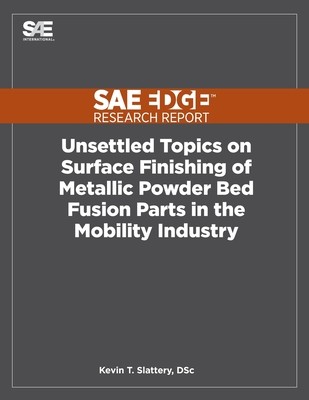
- We will send in 10–14 business days.
- Author: Kevin T Slattery
- Publisher: SAE International
- ISBN-10: 1468602810
- ISBN-13: 9781468602814
- Format: 21.6 x 27.9 x 0.2 cm, minkšti viršeliai
- Language: English
- SAVE -10% with code: EXTRA
Unsettled Topics on Surface Finishing of Metallic Powder Bed Fusion Parts in the Mobility Industry (e-book) (used book) | bookbook.eu
Reviews
Description
Laser (L-PBF) and electron-beam powder bed fusion (EB-PBF) additive manufacturing (AM) technology, or "3D printing," has transitioned from prototypes and tooling to production components of geometries that can only be made using AM in demanding fields such as medicine and aerospace. These initial applications either
Take advantage of the relatively high surface roughness of the process
Are in fatigue, corrosion, or flow environments where surface roughness-higher than that found in cast, machined, or sheet metal products-does not impose performance penalties
To move to the next levels of performance, the surfaces of components made by L-PBF and EB-PBF will need to be smoother than the current as-printed surfaces and will have to achieve this on increasingly more complex geometries. Finally, these surfaces will need to be produced without significantly increasing the cost of the final component.
In this third part of an ongoing series on AM, the challenges, technologies, and opportunities for surface finishing of L-PBF and EB-PBF metallic parts are discussed.
NOTE: SAE EDGE Research Reports are intended to identify and illuminate key issues in emerging, but still unsettled, technologies of interest to the mobility industry. The goal of SAE EDGE Research Reports is to stimulate discussion and work in the hope of promoting and speeding the resolution of identified issues. These reports are not intended to resolve the challenges they identify or close any topic to further scrutiny.
Notes on terminology:
Surface Finishing refers to the use of in-situ processing or post-processing to smooth the surface of a part made using PBF. A primary example is sanding.
Surface Improvement refers to the use of in-situ processing or post-processing to impart compressive residual stresses on the surface of a part to improve fatigue properties. A primary example is shot peening.
EXTRA 10 % discount with code: EXTRA
The promotion ends in 21d.20:48:29
The discount code is valid when purchasing from 10 €. Discounts do not stack.
- Author: Kevin T Slattery
- Publisher: SAE International
- ISBN-10: 1468602810
- ISBN-13: 9781468602814
- Format: 21.6 x 27.9 x 0.2 cm, minkšti viršeliai
- Language: English English
Laser (L-PBF) and electron-beam powder bed fusion (EB-PBF) additive manufacturing (AM) technology, or "3D printing," has transitioned from prototypes and tooling to production components of geometries that can only be made using AM in demanding fields such as medicine and aerospace. These initial applications either
Take advantage of the relatively high surface roughness of the process
Are in fatigue, corrosion, or flow environments where surface roughness-higher than that found in cast, machined, or sheet metal products-does not impose performance penalties
To move to the next levels of performance, the surfaces of components made by L-PBF and EB-PBF will need to be smoother than the current as-printed surfaces and will have to achieve this on increasingly more complex geometries. Finally, these surfaces will need to be produced without significantly increasing the cost of the final component.
In this third part of an ongoing series on AM, the challenges, technologies, and opportunities for surface finishing of L-PBF and EB-PBF metallic parts are discussed.
NOTE: SAE EDGE Research Reports are intended to identify and illuminate key issues in emerging, but still unsettled, technologies of interest to the mobility industry. The goal of SAE EDGE Research Reports is to stimulate discussion and work in the hope of promoting and speeding the resolution of identified issues. These reports are not intended to resolve the challenges they identify or close any topic to further scrutiny.
Notes on terminology:
Surface Finishing refers to the use of in-situ processing or post-processing to smooth the surface of a part made using PBF. A primary example is sanding.
Surface Improvement refers to the use of in-situ processing or post-processing to impart compressive residual stresses on the surface of a part to improve fatigue properties. A primary example is shot peening.


Reviews